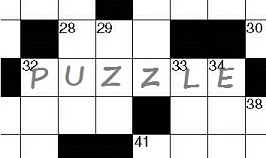
Previous Month | RSS/XML | Current | Next Month
WEBLOG
October 31st, 2025 (Permalink)
Hallowe'en Party
Andy, Betty, Charly, and Debby attended a party on Hallowe'en costumed as a mummy, a vampire, a werewolf, and a ghost, though not necessarily in that order. At the end of the party, there was a best costume contest that each of the four friends entered. As a result, each of the four costumes was ranked from best to worst. Given the following clues, can you figure out what costume each friend wore?
- The contestant in the werewolf costume didn't do as well as the one dressed as a vampire, but didn't come in last among the four friends.
- Andy didn't come out ahead of Betty in the contest, and there was at least one other contestant between them in the ranking.
- The entrant wrapped up in gauze like a mummy came out better in the contest than the one made up as a werewolf, though there was no other contestant between them.
- Debby just barely beat out Charly, who had the next best costume.
What costume was worn by each contestant and in what position did each finish?
Betty was first in the contest wearing the vampire costume; Debby came in second wrapped up like a mummy; Charly, made up as a werewolf, came in third; and, finally, Andy was dead last as a ghost.
October 23rd, 2025 (Permalink)
How to Lie With Notes1: Introduction
This is the first entry in what I hope will be a series of entries on the misuse of notes―that is, footnotes or endnotes―in scholarly or pseudo-scholarly writing.
When I first started reading scholarly works, many decades ago, I recall being baffled by the notes. Some typical notes looked like the following:
14 Ibid.
18 Sutch, op. cit., 429.
19 New York, 1938.2
I recall struggling to understand this arcane language of scholars. It's bad enough that some notes included words taken from a dead language―Latin―but they were abbreviated as well. Moreover, scholarly notes were taught by the "sink or swim" method: you were thrown into the deep end of scholarship and either learned quickly to swim or drowned3.
Scholarly notes, whether at the foot of a page―"footnotes"―or the end of an article, chapter, or book―"endnotes"―are not just pedantry. If used correctly, notes serve useful purposes, but if used incorrectly they can mislead the reader. To understand how notes are misused, we must first understand how they are properly used.
What are notes for? Notes serve more than one purpose, in fact, they have three main uses:
- Citation of sources: Notes of this type cite books or other sources of a scholarly work's claims, which serves the important purpose of making it possible for readers to check those claims. For instance, suppose that a work quotes from another work: how do we know that the other work is not misquoted or quoted out of context? A citation in a note to the work and page or pages quoted means that the quote can be checked for accuracy as well as contextomy. Even if no one ever does so, the fact that the note makes it possible serves as a deterent to conduct unbecoming a scholar. If you're more likely to get caught, you're less likely to cheat. Here's an example of a note of this type:
1 Austen H. Layard, Discoveries in the Ruins of Nineveh and Babylon… London, 1853, 663.4
This footnote is a citation to the source of a lengthy quote included on the same page. The note gives, first, the author's name, then the title of the book, the place and year of publication and, finally, the number of the page where the quote occurs. The ellipsis after the title indicates that the full, lengthy nineteenth-century title has been truncated5.
- Asides and digressions: It's a common and laudable practice to put into notes comments that would break the flow of argument and that a reader could skip without misunderstanding the main points. Such comments can, especially if short, be included in the text in parentheses, but long parenthetical remarks interrupt the reader's train of thought. It's better to exile such remarks to the foot of the page or the end of the book. For example, a logic textbook I own gives an example of modus ponens6 from one of A. A. Milne's books7 and footnotes it as follows:
22 And to think that Eeyore always maintained that Pooh had only fluff in his head!8
This is an amusing aside that will only be understood by readers familiar with Winnie the Pooh, otherwise adding nothing to the discussion of the example.
- Technical elaborations or provisos: These are similar to the digressions and asides of the previous point, but the reason for putting them into a note is different. In this case, the writer places material too technical for many readers, but which more advanced readers may want to read. For instance, the same textbook from which the previous example came remarks in its "Preface to the Instructor": "Where the textual explanation warrants a special comment or remark to advanced readers but students need not read the same comment, or a footnote presupposes special technical background, it is labeled 'Note to Advanced Readers.'"9
It should be noted that these three categories are not exclusive, and perhaps not exhaustive. Some notes combine two of these categories, and it's even possible that a single note could combine all three.
What these three types have in common is that they are written matter that the casual reader may skip without missing anything important to the main discussion. The notes are there for those who want to check sources―type 1―advanced readers who want technical information―type 3―or those who just wish to enjoy an amusing or interesting sidelight―type 2.
If all goes as planned, next month we'll take a brief look at the Latin phrases and abbreviations that have been traditionally used in notes. After that, we'll get into the ways that notes go bad.
Exercise: Test your understanding by classifying the following notes according to the three types above. Keep in mind that a note may be of more than one type and there may be borderline cases.
- Type 2
- Type 1
- Type 2
- Types 1 & 2
- Type 2
- Type 3
- Type 1
- Type 1
- Type 1
Notes:
- ↑ And without.
- ↑ Jacques Barzun & Henry F. Graff, The Modern Researcher (3rd edition, 1977), pp. 29, 184 & 293.
- ↑ The best brief introduction to scholarly notes that I know of is: ibid., chapter 15. Unfortunately, I didn't read this chapter until many years later.
- ↑ Barzun & Graff, p. 3. The fact that I simply cite the last names of the authors and a page number indicates that I've previously given the full citation in note 1, above.
- ↑ The full title is: Discoveries Among the Ruins of Nineveh and Babylon; with Travels in Armenia, Kurdistan, and the Desert: Being the Result of a Second Expedition Undertaken for the Trustees of the British Museum. No wonder it was abbreviated!
- ↑ Modus ponens is a type of argument from propositional logic that has the form: If p then q, p; therefore, q.
- ↑ A. A. Milne, The House at Pooh Corner (1928).
- ↑ Stephen Naylor Thomas, Practical Reasoning in Natural Language (4th edition, 1997), p. 219.
- ↑ Ibid., p. xiii.
October 16th, 2025 (Permalink)
Calvary to the Rescue
A book I was reading recently mentioned a novel I'd never heard of by Anthony Boucher entitled "The Case of the Seven of Cavalry"1, a title that didn't make much sense to me. Is it a western? I know of Boucher as a writer of mysteries and science fiction, rather than westerns. So I checked and discovered that the title is actually The Case of the Seven of Calvary2. It is, in fact, a mystery novel as the beginning of the title―"The Case of the…"― would suggest. The actual title still didn't make much sense to me, but it made more sense than the misspelled one.
Unlike many other word pairs that are often confused, "cavalry" and "Calvary" are pronounced quite differently, at least if enunciated clearly, though some people manage to mispronounce the former as the latter. Following its usual descriptivist practice3, the online Merriam-Webster dictionary actually includes the pronunciation of "Calvary" as a variant pronunciation of "cavalry", though at least it labels it as "nonstandard"4, which means "wrong".
The main reason that the two words are confused is probably that they're anagrams of each other, that is, they have the same letters but in a different order, and if you're reading quickly it's possible to misread one for the other. Despite that similarity in spelling, the words are very different in meaning. "Cavalry", of course, is a noun that historically referred to a group of soldiers on horseback but, by extension, in the twentieth century it came to mean soldiers in tanks or other vehicles that replaced horses5.
"Calvary", in contrast, is a proper noun for a place, namely, a hill outside the wall of Jerusalem where Jesus was crucified, according to the gospel of Luke6. The name comes from the Latin word "calvaria" for the human skull7 and is translated from the Greek word "Golgotha", which itself translates an Aramaic word for "skull". The name is supposedly based on the hill's resemblance to a human skull8, but this is conjecture since no one now knows where this hill was located9.
Not a single one of the reference books I consulted mentions the confusion of "cavalry" and "calvary" despite the fact that this was not the first time, and probably not the second, that I've seen or heard them confused. However, my old copy of Microsoft's Word program automatically changes "calvary" to "cavalry" in phrases such as "send in the calvary" and "the calvary to the rescue" without even asking permission, which is annoying. Moreover, if you search for "calvary" in a search engine10, you may get suggestions that make sense only for "cavalry". All these facts suggest that the confusion is common.
Notes:
- ↑ Robin W. Winks, editor, The Historian as Detective: Essays on Evidence (1970), p. 458.
- ↑ Anthony Boucher, The Case of the Seven of Calvary (1937).
- ↑ I previously complained about Merriam-Webster's descriptivist ways here: Infer or Imply?, 4/2/2022.
- ↑ "Do you send in the 'cavalry' or the 'calvary'?", Merriam-Webster, accessed: 10/8/2025.
- ↑ "Cavalry", Cambridge Dictionary, accessed: 10/7/2025.
- ↑ Luke 23:33. This is the only place in the Bible where "Calvary" is mentioned.
- ↑ Jon R. Stone, Latin for the Illiterati (1996).
- ↑ Ivor H. Evans, Brewer's Dictionary of Phrase & Fable (Centenary edition, revised; 1981). Under "Calvary" and "Golgotha".
- ↑ Michael D. Coogan, The Oxford Companion to the Bible, edited by Coogan & Bruce M. Metzger (1993). Under "Golgotha".
- ↑ For instance, I searched for "define calvary" in Google which suggested the question "What does Calvary mean in the army?" as one that people often ask.
October 13th, 2025 (Permalink)
Lesson on Logic 23: Venn-Euler Diagrams1
In previous lessons, we examined how to use Euler diagrams to evaluate polysyllogisms, but were limited to those involving only universal categorical statements, that is, A- and E-type statements since Euler's technique was deficient when it came to particular categorical statements―that is, I- and O-type statements. We can instead make use of John Venn's technique for representing such statements2, which we learned how to do in previous lessons. If you recall, Venn's method is to place a mark―an "x" or asterisk, for instance―in a subclass to indicate that it is not empty.
This is where things get interesting, because there's no algorithm for combining Euler and Venn diagrams, at least as far as I know. Algorithms are just recipes telling you what to do step-by-step, and they're the mathematical basis for computer programs. Mathematicians and programmers love algorithms but, let's face it, they're boring. There's no room in an algorithm for cleverness or insight. In contrast, to create a Venn-Euler diagram for a categorical argument, you need to keep your wits about you and use your intelligence. Also, be willing to start over again if you make a mistake. Algorithms are for the traveller who wants a computerized navigation system to tell him every turn to take, whereas Venn-Euler diagrams are for the adventurer who likes to set out on a journey into unexplored territory. Let's try an example to see how it's done.
- All hierophants are cellophants.
- No cellophants are sycophants.
- Some hierophants are irrelephants.
- Therefore, some hierophants are not sycophants.
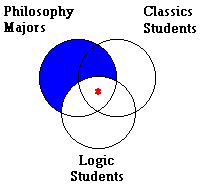
First of all, notice that there is no premiss connecting the two classes of cellophants and irrelephants, which means that we can't represent their relationship with an Euler diagram. If a categorical argument mentions two classes but does not assert that one is a subclass of the other―an A statement―or that they are disjoint―an E statement―then we need to allow for overlap. We learned in a lesson long ago3 how to do this with two classes. Let's start our diagram by representing these two classes, as shown.
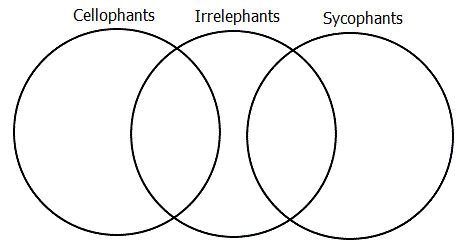
Turning to the class of sycophants, the second premiss tells us that it is disjoint from the class of cellophants, but we're told nothing about its relationship to the class of irrelephants. Therefore, we need to combine an Euler diagram to represent the former relationship and a Venn diagram to portray the latter. The diagram shows that the classes of cellophants and sycophants are disjoint, but that the classes of irrelephants and sycophants may overlap.
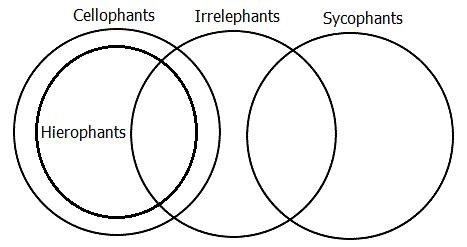
Finally, we need to add a circle for the class of hierophants. The first premiss tells us that it is a subclass of the class of cellophants, so we can represent this in the Euler manner, but how does it relate to the class of irrelephants? The premisses do not say, so we need to use the Venn technique to allow for overlap. The diagram shows that the class of hierophants is a subclass of the class of cellophants, but that the former and the class of irrelephants may overlap.
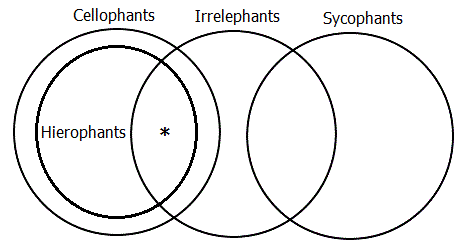
So far, we have diagrammed the first two premisses, so let's do the third and be done diagramming. Since the third premiss is an I statement, we must represent it in Venn's way, by putting a star in the subclass that is said to be non-empty. In this case, that is the overlap region between hierophants and irrelephants, as shown.
Now we can breathe sighs of relief for we're done diagramming, and it's time to evaluate the argument to see whether it's valid. The conclusion is an O statement that claims that the overlap of the class of hierophants with that of non-sycophants is non-empty. In other words, there is a hierophant which is not also a sycophant. If you look at the finished diagram, you will see that it does indeed show this, therefore the argument is valid.
That might have seemed a long process, but I find it both easier and more intuitive than the chain-argument technique of lesson 19. Try the following exercise to see whether you agree.
Exercise: Diagram the following argument using a Venn-Euler diagram then evaluate it for validity.
- All zonkies are wonkies.
- All honkies are donkies.
- Some zonkies are honkies.
- Therefore, some wonkies are donkies.
Valid

Notes:
- ↑ For previous lessons in this series see the navigation panel to the right.
- ↑ See lesson 13.
- ↑ See lesson 11.

October 1st, 2025 (Permalink)
Turn Down the Heat
Yuval Levin, "Have an Argument", The Free Press, 9/14/2025
… Even most politically engaged people don't actually spend much time in active disagreement with people who have different views. We spend most of our time cocooned away with people we agree with, talking about those terrible people on the other side, but rarely actually talk to those people.This feeds the common misimpression that disagreement is a mark of civic failure, and that the very existence of people who don't share our goals and priorities is a problem to be solved. The distinctly 21st-century institutions of our civic life―not only social media but the polarized political press, the one-party university, the one-party church, and an increasingly performative political culture―are all grounded in that misimpression. They are built to let us avoid exposure to conflicting views. …
This is a perverse distortion of the American political tradition. Our Constitution is premised on the assumption that our neighbors aren't always going to share our views, and that dealing with each other through those differences is what politics is for.
"As long as the reason of man continues fallible, and he is at liberty to exercise it, different opinions will be formed," as James Madison bluntly put it.* … The older, more traditional institutions of our politics exist to facilitate disagreement in that light. Legislatures and courtrooms are places to argue with each other. So are universities, properly understood, and newspaper opinion pages. The forms and rules of those institutions are designed to make the arguments that happen there constructive.
The same cannot be said of our digital partisan cocoons. They are not there to facilitate disagreement but to facilitate division. They separate us into distinct subcultures which they then do their best to keep from mixing. They want us surrounded by people we agree with, but obsessed with people we disagree with.
… Politically active people are at war with caricatures of their opponents, but they are not forced to actually confront those opponents as human beings with priorities of their own, or to acknowledge the possibility that what the two sides want might be the starting point for a negotiation toward an outcome they could both tolerate.
And the cultural gravity of these technologies is remaking our traditional civic spaces in their image. The culture of Congress, and of many college campuses, increasingly resembles that of social media. It fosters not disagreement (which inevitably involves mixing with the other side) but division. …
But above all, lowering the temperature will require us to recognize that the people we disagree with are not the problem to be solved. … Our politics does not consist of friends and enemies. It consists of fellow citizens who share a future in common and disagree about how best to shape that future. Those disagreements are serious. But no resolution to them could be absolute or permanent. Our political adversaries will still be here tomorrow; they will be part of any future we build. Any politics not premised in that reality will be dangerously delusional and can only point us down.
The American political system is firmly rooted in that reality. It advances the counterintuitive notion that we can turn down the temperature of our politics by disagreeing with each other more directly and concretely. Its forms, and its history, can teach us how.
* ↑ James Madison, "The Federalist Papers 10", Bill of Rights Institute (1787)
Disclaimer: I don't necessarily agree with everything in this article, but I think it's worth reading in its entirety.